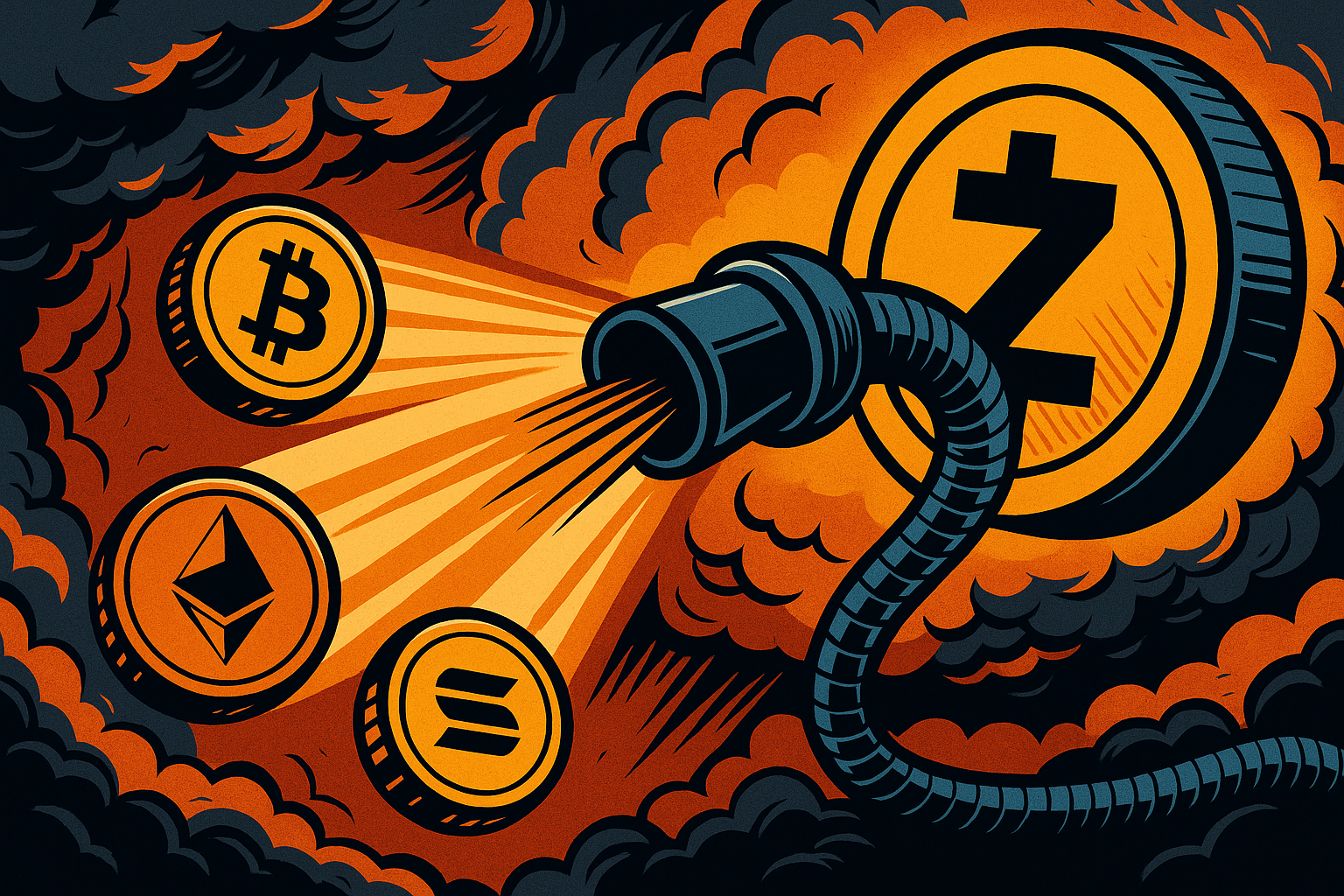Bitcoin
Dimming Margins, Diversification and the Security Question: The State of Bitcoin Mining Post‑Halving

- Share
- Tweet /data/web/virtuals/383272/virtual/www/domains/theunhashed.com/wp-content/plugins/mvp-social-buttons/mvp-social-buttons.php on line 63
https://theunhashed.com/wp-content/uploads/2025/10/bitcoin_mining_profitability_asics-1000x600.png&description=Dimming Margins, Diversification and the Security Question: The State of Bitcoin Mining Post‑Halving', 'pinterestShare', 'width=750,height=350'); return false;" title="Pin This Post">
For years, Bitcoin mining was a high‑stakes race where specialized machines churned out coins and secured the network. But in the wake of the latest halving, soaring costs and shrinking subsidies have forced miners into a new reality: either adapt or risk being squeezed out. The implications ripple far beyond balance sheets—into the very security of the Bitcoin network.
The profitability squeeze: current vs past
To understand the state of mining profitability today, one must look at both the evolving economics (hardware, electricity, network difficulty) and the top‑line reward environment for miners.
Past profitability
Prior to the April 2024 halving (when the block subsidy dropped from 6.25 BTC to 3.125 BTC) miners enjoyed relatively healthy margins assuming stable electricity costs, efficient rigs and modest competition. In 2016‑20, the block subsidy and Bitcoin price rises offered strong headwinds in miners’ favour. A historical chart shows that mining profitability (measured as USD per TH/s) has steadily declined over time. Even after the 2020 halving, miners benefited from higher Bitcoin prices which somewhat offset the cut in subsidy.
Current conditions
Today, mining profitability is under intense pressure. Real‑time calculators show modest profits: for example, one calculator using 390 TH/s at 7.215 kW electricity consumption at $0.05 per kWh estimated daily profit around $9.92 at a BTC price of around $111,000. Other trackers show values of only a few cents per TH/s per day. Several ASIC profitability monitoring services list very low returns even for the latest machines.
A major factor: the subsidy halved in 2024, dropping to 3.125 BTC per block at block 840,000.
Further, network difficulty and total hash rate continue to climb, meaning each miner’s share of the issuance is squeezed.
On the revenue side, transaction fees remain a relatively small portion of miner revenue—often only a single‑digit percent of total miner revenue.
All of this means: unless miners have very low electricity costs, efficient machines and good utilisation, profitability is constrained.
Bottom‑line comparison
In the past, miners could rely on a higher subsidy relative to network hash rate, and across a cycle they could amortise hardware and generate robust returns. Today, with the subsidy cut in half and rising operational costs (electricity, cooling, infrastructure), the margin cushion is much thinner. In short: profitability is significantly worse today for a given machine and electricity cost set than in the pre‑halving era.
Who’s struggling (and pivoting)
The challenging economics have forced many miners to adapt or fail.
Bankruptcies and distress
Several mining firms have filed for bankruptcy or serious restructuring. For example, Compute North filed for bankruptcy in September 2022 following over‑extension and a deteriorating mining business. Core Scientific also filed for Chapter 11 in late 2022. More recently, the U.S. miner Rhodium Encore LLC has been in bankruptcy proceedings. These cases underline how tight margins and high fixed costs (power contracts, lease obligations, hardware financing) have become existential threats.
Pivots into AI and infrastructure
On the flip side, some miners are shifting gears rather than digging deeper into mining per se. CleanSpark announced a strategic expansion into AI‑data‑centres to diversify revenue beyond Bitcoin mining. Another company, Iren (formerly Iris Energy), reported a major increase in AI‑cloud capacity and GPU deployments while continuing mining operations. A broader industry narrative from mid‑2025 also highlights miners converting facilities to AI infrastructure as mining profitability wanes.
This shift makes sense: the same low‑cost power and data‑centre infrastructure used for mining can sometimes be repurposed for high‑performance compute (HPC) needed in AI/ML workloads, offering potentially steadier cash flows.
Why this matters to Bitcoin’s security
Mining is not just about profit. In the Bitcoin system, miners secure the network by expending real economic resources (electricity, hardware) to perform Proof‑of‑Work (PoW). If miners’ economic incentives weaken, then certain security risks emerge.
Subsidy dominance and fee weakness
Currently, miners derive the bulk of their revenue from the block subsidy (newly minted bitcoins) rather than transaction fees. According to analysis, fees remain a small share of mining revenue.
This means the network remains reliant on the issuance subsidy to sustain security. As more halvings occur (every ~4 years) the subsidy will continue to drop, placing greater reliance on fees—and if fees don’t rise sufficiently, miners’ incentives may diminish.
Cost‑intensive PoW
PoW is inherently cost‑intensive: electricity, equipment depreciation, cooling and operational overheads. When revenue is squeezed (as we see today) miners will be more selective in operations, may shut down less efficient rigs, or leave the network if unprofitable. This could reduce hash‑rate, increase block times, increase centralisation risks, or make the network more vulnerable to attack (e.g., 51% or selfish mining scenarios). Some academic work suggests that when miner reward is low relative to cost, opportunistic behaviours increase.
In short: there is a direct line from miner profitability → miner participation → network hash‑rate → Bitcoin security.
Transaction volume and fee risk
Because fees are currently small, if the subsidy drops significantly (future halving) and fees don’t fill the gap, miners may face unprofitable conditions. If enough miners drop out or consolidate, the decentralised security premise of Bitcoin may erode. The fact that fees haven’t yet scaled to replace subsidies is a structural risk.
The role of the 2024 halving
The most recent halving in April 2024 dramatically increased the pressure. The block subsidy was cut in half—from 6.25 BTC to 3.125 BTC per block. While Bitcoin price and fee revenue could in theory compensate, in practice many miners found the margin squeeze severe.
When the subsidy is halved, unless difficulty or competition falls correspondingly, or the price of Bitcoin rises, each miner’s revenue share drops. Many miners may have assumed that the price would jump, but as often, timing and magnitudes matter. Many are now scrambling for efficiency or alternative revenue.
In short: the 2024 halving is a key root cause of the current stress in mining economics.
Future outlook: what to expect
Given the current trajectory, here are some reasoned projections and caveats for what may come next.
Consolidation and exit of inefficient players
We should expect further shutdowns or restructuring among miners with high electricity costs, older rigs, or heavy debt loads. The winners will be those with ultra‑low power tariffs, efficient machines, and flexible cost structures (including diversification into AI or other compute workloads).
More shifts into compute/AI infrastructure
The pivot into AI/data‑centre business seems likely to accelerate. Miners already have power contracts, infrastructure and some operational scale; switching or adding AI workloads gives them another revenue stream beyond mining. That may become a survival strategy for the sector.
Fee dynamics and security implications
For Bitcoin’s security model to remain strong long‑term, transaction fee revenue must grow (or remain at least stable) relative to mining cost. If fees stay low and the block subsidy keeps halving, miners’ incentives will compress further. Monitoring the ratio of fee revenue to subsidy (currently small) is important.
Should miner participation decline, hash‑rate drops, difficulty adjustment lag or centralisation increase, then security margins thin.
Mining cost of production will be key
The breakeven cost of producing one Bitcoin (or share thereof) will increasingly determine which operations survive. As hardware innovation slows (ASIC gains are incremental) and electricity is a major cost, geographic/regulatory arbitrage will matter. Some regions with cheap renewables or stranded power may be the winners.
Bitcoin price remains wild‑card
A rising Bitcoin price can mask or offset reduced subsidy, so macro price trends remain relevant. But relying solely on price increases is risky for miners — structural cost issues remain.
Longer‑term view: halving drift
Looking further out, as subsidies continue to shrink (every ~4 years until issuance ends), the mining industry will gradually shift from “coin creation” to “transaction‑processing revenue”. If that transition fails, the network may face incentive misalignment. Academic work warns that if miner reward is too low, network security or decentralisation may suffer.
In effect: mining economics today are a preview of the long‑term challenge that Bitcoin must navigate.
Conclusion
The economics of Bitcoin mining have entered a tougher, more challenging phase. The halving in 2024 cut the subsidy at the same time as costs remained high and difficulty stayed elevated. Many miners have adopted new strategies—shutting inefficient rigs, exiting, or pivoting into AI/data‑centre infrastructure. This isn’t just a business issue: mining profitability has direct implications for the security of the Bitcoin network, which still relies heavily on subsidy‑driven rewards rather than fees. The key question for miners and for the network alike is whether rising fees, operational efficiencies and price appreciation will fill the gap. If not, the network could face structural risk.
Bitcoin
Quantum Computing Could Unlock Lost Bitcoin — Analysts Say

An on‑chain analyst argues that the looming arrival of powerful quantum computers may trigger one of the most disruptive moments in Bitcoin’s history. Not because quantum hardware is suddenly able to break Bitcoin’s cryptography today, but because of how the network might respond (or fail to respond) to the threat.
Threat #1: Dormant Bitcoin supply at risk
A key point in the article is that a large portion of Bitcoin’s supply lies in wallets that have not moved for years. According to one data source cited, about 32.4 % of all Bitcoin hasn’t moved in over five years, and about 16.8 % has been dormant for more than a decade.
Why is that relevant? These unmoved coins are often assumed to be “lost”, though not always—some might simply be long‑term holdings or cold wallets. The analyst, James Check of Checkonchain, argues that these coins are the first potential targets in a quantum attack scenario, because many of them use older address formats and signature schemes which might be more exposed.
Threat #2: Cryptography vulnerability
The article identifies that Bitcoin currently uses elliptic‑curve digital signature algorithms (ECDSA) and Schnorr signatures. These rely on locked‑in algorithms that could theoretically be broken by sufficiently powerful quantum computers using, for example, Shor’s algorithm.
It’s noted that the National Institute of Standards and Technology (NIST) has already approved several quantum‑resistant signature schemes, and that the Bitcoin community has proposals (such as BIP 360) to adopt post‑quantum cryptography. But moving from proposal to consensus to deployment is non‑trivial in a decentralized network like Bitcoin.
Political/governance risk over purely technical risk
The article argues that the more acute risk isn’t necessarily “quantum hardware tomorrow breaks Bitcoin” but rather the governance and coordination challenge of how to deal with the switch to quantum‑resistant protocols, especially when old coins are involved. If coins migrate to quantum‑resistant addresses, fine. But if a large amount of Bitcoins remain in older address formats, those coins potentially become vulnerable (if quantum attacks arrive).
One quote:
“Actually, I think a lot of confusion on quantum and BTC is that everyone frames it as a tech problem, but what makes the problem specifically unique to BTC is that the tech problem is secondary.”
In short, the article frames this as a “political” / consensus / transition risk more than an immediate technical collapse.
Timeline and technical feasibility
The article provides estimates of how many qubits might be required for an attack. For instance, one estimate suggests that on the order of 126,000 physical qubits might be required to break elliptic‐curve signatures securing Bitcoin wallets. Another posits that 2,300 logical qubits might suffice under certain conditions.
However, not all experts agree the threat is near‑term. For example, Adam Back, CEO of Blockstream, is quoted as saying the quantum threat to Bitcoin is at least 20–40 years away, because today’s machines are noisy and need extensive error correction.
Strategic implications for Bitcoin holders & ecosystem
What does this article mean for someone holding Bitcoin, or for ecosystem watchers? A few key takeaways:
- If you are holding Bitcoin in long‐term static addresses (especially older address types which expose public keys once redeemed), there is a future risk (though not necessarily immediate) that those coins are more “vulnerable” than ones you migrate to quantum‑safe addresses.
- The Bitcoin ecosystem will need to coordinate a migration (or upgrade) to quantum‑resistant cryptography, which includes both technical (algorithm selection, wallet implementations) and governance coordination (how to treat old addresses, how to migrate coins, whether to freeze some addresses, etc).
- There may be “first mover” opportunity or risk around large dormant wallets. If quantum‑capable adversaries begin harvesting public keys from blockchain data now (a “store now, attack later” strategy) then long‑inactive addresses could be tempting targets.
- The horizon remains uncertain: whether we talk about late 2020s, 2030s, or even 2040s depends on assumptions about quantum hardware progress. But the article makes clear the discussion is increasingly serious among institutional actors. For example, the Government of El Salvador (cited in the article) split its Bitcoin holdings across many addresses explicitly citing quantum risk.
My additional perspective and commentary
From my vantage point the article is valuable, but there are nuances worth emphasizing. First, despite the attention, no known quantum computer today can actually break Bitcoin’s signature scheme in the wild. The estimates of qubit counts are large and assume many breakthroughs in error correction and scaling. So the threat is realistic, but not imminent in the sense of “tomorrow your coins vanish”.
Second, the transition to quantum‑resistant cryptography is easier said than done. In Bitcoin’s case, the network must agree on the changes (via BIPs, deployment, miner/node support) and then wallets/exchanges must roll out support without fracturing the ecosystem. The article correctly frames the governance as the bottleneck.
Third, for holders my advice is conservative: maintain strong security practices, monitor whether your wallet provider or service supports quantum‑resistant schemes (or has migration plans). If you hold coins in cold storage in older address formats and you’re planning to hold for decades, then this topic should at least be on your radar.
Finally, this story intersects with AI: the article mentions that advances in AI‑driven quantum‐algorithm research could accelerate the timeline (for example, discovering more efficient quantum attack algorithms). So it’s not just hardware; software breakthroughs matter.
Bitcoin
Wall Street Pulls Back on Proxies as Direct Bitcoin Access Becomes Mainstream

In a decisive shift within institutional finance, major funds have quietly trimmed roughly $5.4 billion in holdings of StrategyB (MicroStrategy) (ticker: MSTR) during the third quarter of 2025. What once served as a convenient equity‑based route to Bitcoin exposure is now being sidelined as direct crypto access becomes more efficient and regulated. According to aggregated filings, institutional paper value in MSTR dropped from approximately $36.3 billion to $30.9 billion—a decline of about 14.8 percent.
The Rise of the Proxy Trade
MicroStrategy transformed from enterprise software company into the de‑facto “shadow Bitcoin ETF” when its leadership embraced Bitcoin accumulation in 2020 under Michael Saylor. Because many institutional allocators were constrained from buying the digital asset outright, MSTR offered a regulated, listed vehicle whose fortunes moved in tandem with Bitcoin’s. At its peak, the stock traded at nearly twice the value of its net Bitcoin holdings per share, reflecting a scarcity premium and strong demand for indirect crypto exposure.
A Quiet Unwind in Q3
Despite Bitcoin trading relatively steadily through Q3—hovering near $95,000 and even touching a new all‑time high above $125,000—the reduction in MSTR holdings cannot be attributed to market stress or forced liquidations. The evidence points to a conscious decision by institutions to scale back this proxy. As many as dozen large managers, including Vanguard, BlackRock and Fidelity, pulled back more than a billion dollars each from MSTR. This is not a collapse, but a measurable pivot in strategy.
Why Now? The Growing Use of Spot Bitcoin and ETFs
The timing of this shift mirrors the maturing institutional environment around Bitcoin access. With spot Bitcoin ETFs and other regulated custodial solutions gaining momentum, many large portfolios no longer require an equity wrapper to gain crypto exposure. The original appeal of MSTR—liquid, listed, and regulatory friendly—has eroded. Its role is evolving from essential access point to one of several optional strategic vehicles.
Implications for MicroStrategy and Its Investors
MicroStrategy remains a massive player, with more than $30 billion still held in institutional exposure. However, the era in which it stood as the sole efficient gateway to Bitcoin on Wall Street is over. Going forward, the risks inherent in its structure—corporate leverage, equity dilution, dependency on Bitcoin performance—will carry greater weight. Investors seeking pure Bitcoin exposure may increasingly bypass the corporate overlay and go directly into crypto or spot ETFs. For those who stay with MSTR, the strategy may warrant reclassification: from broad crypto proxy to tactical instrument with corporate‑wrapped risks.
What to Monitor Going Forward
A few key timelines and metrics will help clarify how this shift plays out. First, Q4 filings will signal whether institutions continue to reduce exposure, hold steady, or begin re‑investing in MSTR. Second, Bitcoin’s performance will matter: a sustained rally above $100,000 may reinforce MSTR’s appeal, whereas a drop toward $80,000 will test corporate wrapper risk in sharper relief. Finally, broader adoption of regulated crypto vehicles will determine if proxies like MSTR become niche or mainstream strategic options.
In sum, the unwind of MSTR holdings marks an institutional inflection point. It signals greater confidence in direct Bitcoin access and highlights the evolving nature of crypto integration within mainstream finance.
Bitcoin
MicroStrategy Faces Index Exclusion as Bitcoin Bet Backfires

What started as one of the most audacious moves in corporate finance—an enterprise software firm morphing into a Bitcoin holding company—now faces an existential challenge. MicroStrategy’s stock (MSTR), championed by chairman Michael Saylor as the regulated bridge for institutional Bitcoin exposure, is on the verge of being removed from the Nasdaq 100 and MSCI USA indexes. For a company whose identity is built on the crypto narrative, index exclusion could signal a turning point with far-reaching consequences for markets, investors, and Bitcoin’s institutional pathway.
Why Index Inclusion Matters
Inclusion in indices like the Nasdaq 100 or MSCI USA isn’t just cosmetic—it directly influences capital flows. Index-tracking funds and ETFs buy shares of included companies by default, providing consistent demand. Removal, however, triggers mandatory selling by those funds. JPMorgan analysts estimate MicroStrategy could see passive outflows of up to $2.8 billion if removed from MSCI alone. If other indexes follow, the total could climb to $9 billion.
That scale of mechanical selling could compress liquidity, reduce valuation multiples, and increase funding costs for MicroStrategy—all while shrinking one of Bitcoin’s key institutional access points.
Why Is MicroStrategy at Risk?
The trigger lies in MicroStrategy’s evolving identity. Once known for its business intelligence software, the company now holds over 600,000 BTC—more than 3% of the global supply. Its value is increasingly tied not to revenue or earnings, but to the market price of Bitcoin.
MSCI recently launched a consultation on whether companies that derive the majority of their value from digital asset holdings should be classified as operating companies or investment vehicles. The proposal considers excluding firms whose crypto reserves exceed 50% of total assets. MicroStrategy is a textbook case.
Further complicating matters, the company’s stock performance and valuation have become closely tied to Bitcoin, sometimes acting as a leveraged bet on its price. That volatility and lack of operational diversification make it a risky outlier for traditional equity indices.
The Numbers Behind the Shift
MicroStrategy’s valuation premium has faded. At one point, investors were willing to pay well above the spot value of its Bitcoin stash—effectively rewarding the company’s bold positioning. That premium has eroded. The mNAV (market cap to net asset value) has shrunk to around 1.1, indicating the stock trades only slightly above the value of its crypto holdings.
Since October, Bitcoin has slid by more than 30%, and MicroStrategy’s stock has fallen around 60% from its 2024 peak. With fewer buyers and more volatility, its resemblance to a traditional tech stock is diminishing fast.
What Happens Next?
MSCI is expected to finalize its decision by January 15, 2026. If MicroStrategy is removed, passive index funds would likely begin selling immediately upon rebalancing, putting additional pressure on the share price. Other indexes—such as Nasdaq or Russell—may follow MSCI’s lead, compounding the impact.
Importantly, the company would not be delisted from stock exchanges. It would still trade on Nasdaq, but it would no longer be included in key benchmarks that guide institutional allocations. That distinction could dramatically change the company’s capital access and visibility.
Implications for Investors and Bitcoin
For MicroStrategy, index removal would reduce access to passive capital and potentially weaken its long-term treasury strategy. For investors, it could trigger a reassessment of exposure to crypto-proxy equities. And for Bitcoin, it may eliminate one of its highest-profile institutional champions from mainstream finance.
MicroStrategy has long served as a regulated, public-market conduit for Bitcoin investment. If removed from key indices, that role may diminish, shifting investor focus to emerging alternatives like spot Bitcoin ETFs or other publicly traded companies with more diversified business models.
Strategic Lessons
MicroStrategy’s journey offers two key takeaways. First, aligning a company too closely with digital assets introduces index eligibility risks—even if it boosts short-term valuation. Second, the line between innovative strategy and structural risk can blur quickly when regulation and index rules shift.
As January 2026 approaches, all eyes are on whether MicroStrategy can retain its position in traditional finance’s upper echelon—or whether it will be cast out as a crypto anomaly in a world of more conventional capital.
-

 Cardano2 months ago
Cardano2 months agoCardano Breaks Ground in India: Trivolve Tech Launches Blockchain Forensic System on Mainnet
-

 Cardano2 months ago
Cardano2 months agoCardano Reboots: What the Foundation’s New Roadmap Means for the Blockchain Race
-

 Cardano2 days ago
Cardano2 days agoSolana co‑founder publicly backs Cardano — signaling rare cross‑chain respect after 2025 chain‑split recovery
-

 Bitcoin2 months ago
Bitcoin2 months agoQuantum Timebomb: Is Bitcoin’s Foundation About to Crack?
-

 Cardano2 months ago
Cardano2 months agoAfter the Smoke Clears: Cardano, Vouchers, and the Vindication of Charles Hoskinson
-

 Cardano2 months ago
Cardano2 months agoMidnight and Google Cloud Join Forces to Power Privacy‑First Blockchain Infrastructure
-

 Ripple2 months ago
Ripple2 months agoRipple CTO David “JoelKatz” Schwartz to Step Down by Year’s End, but Will Remain on Board
-

 News2 months ago
News2 months agoRipple’s DeFi Awakening: How mXRP Is Redefining the Role of XRP









